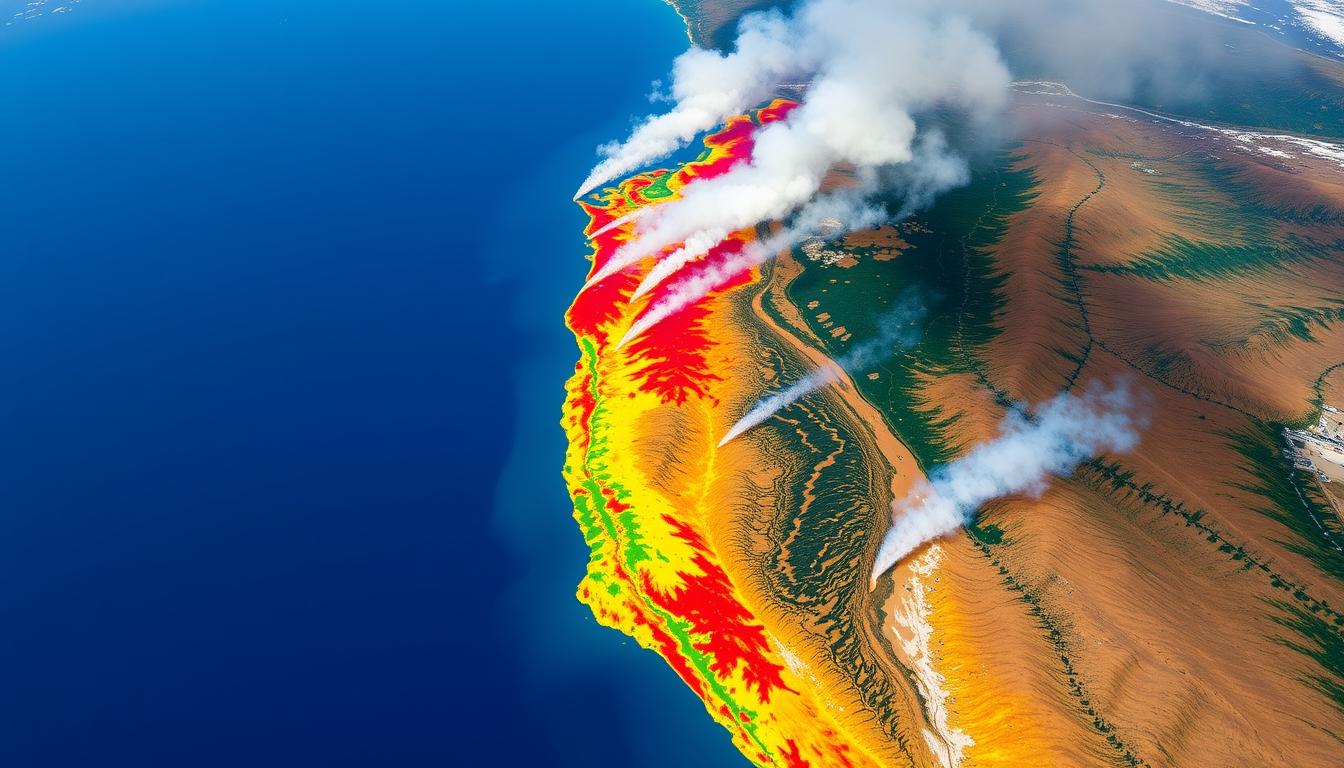The Real-Time California Wildfire Map is key for Californians to stay updated on fires. Wildfires are common now, and this map offers quick updates for safety. The Palisades Fire has destroyed over 17,234 acres and more than 1,000 structures.
Access to a real-time fire map is crucial. It helps communities understand fire risks and get alerts fast. With nearly 180,000 people evacuated and five deaths, staying informed is vital for safety.
Whether you’re affected or just want to stay informed, this tool is helpful. It boosts your awareness and readiness for emergencies.
Key Takeaways
- The california fires map provides real-time tracking of active wildfires.
- Over 17,000 acres have burned due to the Palisades Fire, marking a record in Los Angeles history.
- Accessing timely wildfire alerts can help protect lives and property.
- Hundreds of thousands of individuals are currently under evacuation orders due to escalating fire risks.
- Interactive features help users navigate and understand the wildfire landscape effectively.
Understanding California’s Fire Season
California’s fire season is unique, shaped by nature and human actions. Fires have caused huge damage and forced people to leave their homes. Knowing why wildfires start helps communities prepare and respond better.
Climate change and people moving into natural areas have made wildfires more common. This has led to longer fire seasons.
What Causes Wildfires in California?
Many things cause wildfires in California. Extreme weather like long droughts, hot temperatures, and strong winds are big factors. The drought has made plants very dry, making fires spread fast.
People also play a big role. This includes using equipment and not managing land well near homes.
Key Seasons for Wildfire Activity
The fire season in California usually lasts from June to October. These months are the hottest and driest, making fires more likely. September and October are often the worst months for fires.
In recent years, more wildfires have happened. This shows a worrying trend of more and bigger fires.
| Year | Total Wildfire Incidents | Acreage Burned |
|---|---|---|
| 2023 | 7,127 | 324,917 |
| 2022 | 7,477 | 331,358 |
| 2021 | 7,396 | 2,569,386 |
| 2020 | 8,648 | 4,304,379 |
Importance of Monitoring Wildfire Activity
Watching wildfires is key to keeping communities safe and reducing damage. Real-time data helps respond quickly, making a big difference. As fires grow, knowing the dangers and conditions is crucial.
Protecting Life and Property
Local authorities often warn of high fire risks with alerts. These warnings are due to hot weather, low humidity, and strong winds. This makes it urgent to monitor wildfire activity closely.
When it’s time to leave, ignoring warnings can lead to legal trouble. Homeowners can use systems like Frontline Wildfire Defense to protect their homes. This helps keep people and property safe from fires.
Impact on Local Ecosystems
Wildfires harm more than just people. They can destroy habitats and change landscapes forever. Monitoring technology helps understand these effects.
Satellites like NOAA’s GOES and NASA’s EOS track fires. This data is vital for recovery. Knowing how fires affect plants and animals helps in restoring nature. This shows why constant monitoring is essential to protect the environment.
Features of the California Fires Map
The California Fires Map is a key tool for tracking wildfires in the state. It offers california fire features that go beyond just showing where fires are. Users can see where fires are now and how much they’ve been contained. This helps people stay up-to-date during emergencies.
Interactive Map Functionality
The interactive fires map makes it easy to explore fire data. You can zoom in and out and filter by specific fires. This lets users find important details like how big a fire is and where it’s spreading. It helps users quickly understand the fire situation.
Accessibility and User Experience
It’s important that the map is easy for everyone to use, especially when fires are happening. The map works well on phones and tablets, so you can get updates anywhere. Its design makes it simple to use, encouraging people to check it often for fire updates.
How to Use the California Wildfire Map
The California Wildfire Map is a key tool for tracking fires and staying safe. This navigation guide will show you how to use it. It also highlights wildfire indicators to watch for.
Step-by-Step Guide to Navigation
To start using the California wildfire map, you need to know its features. Here’s how to begin:
- Access the Map: Visit the California wildfire map webpage.
- Select Your Area: Zoom in on your area or enter your address to see local fires.
- Review the Layers: Switch between layers to see fire perimeters, smoke density, and evacuation zones.
- Check the Updates: The map updates every hour. Refresh it often for the latest safety info.
- Interpret the Data: Look for color-coded areas to understand fire intensity and containment status.
Key Indicators to Watch
Knowing important wildfire indicators helps you make smart choices during emergencies. Here are key things to look for:
- Fire Intensity: Darker colors mean higher intensity fires.
- Containment Status: Check updates on fire containment.
- Evacuation Zones: Watch for areas under evacuation orders.
- Smoke Density: Areas with thick smoke may have poor air quality.
- Social Vulnerability Index: This layer shows populations at risk from smoke.
With over 170,000 acres burned and many evacuations, knowing these indicators is crucial. Stay informed, prepared, and check the California wildfire map often. This will help keep you and your community safe.
Latest Updates on Active Fires
It’s important to stay updated on active fires, especially if you live in affected areas. In the Los Angeles area, the situation is critical. Multiple wildfires are burning, and many people have had to evacuate.
Over 7,500 firefighters are working hard to fight the fires. They are making sure everyone stays safe.
Current Wildfire Alerts and Conditions
Thursday morning saw at least five fires in the Los Angeles area. The Palisades Fire has burned over 17,234 acres. The Eaton Fire has scorched about 10,600 acres.
More than 130,000 people have had to leave their homes. Almost 180,000 are under evacuation orders. Sadly, five people have died because of the Eaton Fire.
Interactive Alerts to Follow
Interactive fire alerts can give you updates in real-time. This way, you can stay informed about the fires. With almost 200,000 under evacuation warnings and over 420,000 without power, these alerts are crucial.
Keeping an eye on the situation helps communities stay safe during this risky time.
Understanding Fire Danger Ratings
Fire danger ratings are key to knowing the wildfire risk in an area. They range from low to extreme. Each level gives important info that affects community safety. It’s crucial for people to understand these ratings during wildfire season.
What Do Different Ratings Mean?
The National Fire Danger Rating System (NFDRS) has five levels of fire potential:
- Low: Fires are unlikely to spread.
- Moderate: Fires can ignite and spread, but usually with great effort.
- High: Fires can spread quickly; caution is advised.
- Very High: Rapid-fire spread is probable; heightened awareness necessary.
- Extreme: Fires can start and spread with extreme intensity, requiring immediate action.
This system helps people and local authorities understand fire risks. It guides them in preparing for fires. For example, an IC of 40 means 40% of firebrands need quick suppression.
How Ratings Affect Community Safety
Fire danger ratings directly influence community safety plans. As ratings rise, so does the need for action. Knowing these ratings helps residents protect their homes. This might include:
- Clearing flammable materials from around homes.
- Creating defensible spaces.
- Being ready for potential evacuation plans.
The California Public Utilities Commission (CPUC) and Cal Fire use these ratings for fire hazard maps. This helps communities spot high-risk areas. It helps them protect lives and property. Using these resources builds resilience against wildfires.
Resources for Fire Preparedness
With wildfires on the rise, it’s more important than ever to have good fire preparedness resources. Safety checklists help families make evacuation plans and get the right supplies. These tools make it easier to be ready for emergencies.
Comprehensive Safety Checklists
Safety checklists are key to being ready for fires. They help with important tasks like:
- Creating a family evacuation plan.
- Gathering important documents and medications.
- Stocking up on food, water, and other necessities.
- Identifying safe meeting points outside of danger zones.
Having these checklists ready helps families make quick decisions in emergencies. This can save lives.
Local Emergency Contacts
Knowing who to call in emergencies is crucial. It can mean the difference between life and death. Important contacts include:
| Service | Contact Number |
|---|---|
| FEMA | 1-800-621-3362 |
| American Red Cross | 1-800-RED-CROSS (1-800-733-2767) |
| California 211 Service | 2-1-1 |
| California Poison Control | 1-800-222-1222 |
| Legal Assistance Hotline | 888-382-3406 |
These contacts offer vital help, from shelter to legal advice during disasters. Keeping these numbers close ensures a swift response to emergencies.
How to Stay Informed During a Fire
It’s key to stay informed during fires to stay safe. In the chaos of a wildfire, getting timely and accurate info is crucial. Trusted news and social media give updates, while apps help keep you safe.
News Outlets and Social Media Tracking
News outlets like CNN and BBC keep you updated. Local stations in California also offer coverage. Following CAL FIRE on social media gives you direct updates.
This way, you get info on evacuations and safety tips fast. It helps you stay informed and safe during fires.
Apps for Real-Time Updates
Apps like FIRIS from CAL OES are vital during wildfires. They alert you to new fires and evacuation zones. These apps have:
- Interactive maps for ongoing fires
- Push notifications for nearby fires and evacuations
- Community forums for sharing info and support
Keeping an eye on these platforms helps you respond quickly. It’s crucial to have them ready, especially during wildfire season. Using these tools makes you more prepared for wildfires.
| Resource | Type | Main Features |
|---|---|---|
| CAL FIRE | News Outlet | Official updates on fire incidents and safety tips |
| FIRIS | App | Real-time fire information and mapping |
| Watch Duty | App | Wildfire alerts and firefighting efforts tracking |
| Social Media | Live updates from CAL FIRE and community engagement |
Community Support and Resources
When wildfires hit, community support is key. Volunteer groups offer shelter and help to those who lost their homes. They work hard to keep spirits high during tough times.
Local governments also step up with financial and logistical aid. This support helps families start their recovery journey.
Volunteer Organizations Helping Evacuees
In California, many volunteer organizations spring into action during wildfires. They provide:
- Temporary shelters for displaced families
- Food and clothing distribution
- Emotional support through counseling and community engagements
- Help with navigating recovery resources
These groups make sure evacuees don’t face their challenges alone.
Local Government Assistance Programs
Government help is crucial after wildfires. Local programs offer:
- Financial aid to cover immediate needs and rebuilding efforts
- Emergency response coordination to streamline recovery efforts
- Access to critical information for affected homeowners and businesses
These resources are vital for rebuilding. They help those in high-risk areas find hope and support.
The Role of Technology in Fire Management
Technology is changing how we manage fires, making responses better and predictions more accurate. Drones and artificial intelligence are key in this change. They make operations smoother and help manage fire risks better.
Drones and Remote Sensing
Drones for monitoring fires have grown fast, doubling in a few years. CAL FIRE uses them to get close to fires and map firefighting efforts in real-time. This helps firefighters know where to go and how fast.
Adding 24 new firefighting planes to California’s fleet helps fight fires quickly. This shows how technology boosts firefighting efforts.
AI in Predicting Fire Spread
Artificial intelligence is key in predicting fire spread. It uses data from satellites and sensors to spot fires and predict their behavior. Companies like PriviNet use AI to detect smoke from far away, speeding up responses.
Partnerships, like with the U.S. Department of Defense, help use technology better. This is a big step forward in fighting fires.
California has invested $4 billion in fighting wildfires. This shows a strong commitment to using technology to protect lives and property. With more money for programs, the state is ready to keep improving its firefighting strategies.
Environmental Impact of Wildfires
Wildfires have big effects on both nature and people. They can destroy homes, harm air quality, and threaten animals. It’s important to know how they affect us now and in the future to help fix things.
Short-term and Long-term Effects
Wildfires can cause a lot of damage right away. For example, the Kincade Fire in Sonoma County burned 77,000 acres in 13 days. This makes animals lose their homes and can mess up the local ecosystem. It also makes the air very bad, which is bad for people’s health.
Long-term, the problems get even bigger. Without plants, the soil can wash away, harming water quality. Also, new plants might not grow, letting bad plants take over. As wildfires get worse because of climate change, they could hurt nature even more.
Recovery Efforts for Affected Areas
Trying to fix the damage from wildfires is a big job. It involves:
- Reforestation: Planting native trees to bring back lost habitats.
- Soil Restoration: Fixing the soil to stop erosion and make it healthy again.
- Water Quality Monitoring: Keeping streams and rivers clean for animals.
Getting the community involved is key. Local groups and government work together to help. They make sure people have food, water, and a place to stay. Fixing the damage from wildfires needs a big effort to help both the land and people.
Future of Wildfire Management in California
California is facing big challenges with wildfires. The future of managing these fires involves new techniques and laws. In 2023, over 700,000 acres were treated to make forests safer. The state plans to spend $2.6 billion over seven years on this effort.
Every year, $200 million will go towards keeping forests healthy and preventing fires.
Innovations in Firefighting Techniques
New technologies are key in fighting fires. CAL FIRE is using drones more to check on fires and start them safely. This makes their work more efficient.
Tools like the Fire Integrated Real-Time Intelligence System (FIRIS) help track fires. They also use eco-friendly methods, like safer chemicals, to protect the environment.
Legislative Efforts and Policies
New laws are also important in fighting wildfires. California wants to grow its firefighting team by 2,400 members in five years. This will help the state stay ready for fires.
By combining new firefighting methods with strong laws, California is getting better at managing wildfires. This makes the state safer and more prepared for the future.




